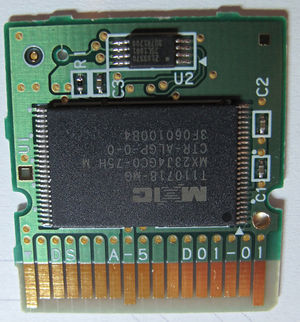Gamecards


Physical interface
The 3DS gamecards have the same physical interface as regular DS and DSi gamecards. There is only a minor cosmetic difference in the plastic case, which has a small extruding notch on the top-right side. As such, it prevents insertion of the gamecard into old Nintendo DS or DSi systems.
When modifying the case so that the 3DS gamecard fits in a DS or DSi system, those systems will refuse to detect the gamecard and show no banner icon.
| Pin | Name | Description |
|---|---|---|
| 1 | GND | Ground |
| 2 | CLK | Clock. Frequencies 6.7MHz and 4.2MHz) |
| 3 | NC | Not connected. Possibly used to program cards. |
| 4 | RCS | ROM select, active low. Pulled low to start a ROM transfer. |
| 5 | RST | Reset, active low. |
| 6 | ECS | Savegame chip select, active low. Pulled low to start a savegame SPI transfer. |
| 7 | IRQ | Removal detection. |
| 8 | VCC | Powersupply 3.3V. |
| 9 | DAT0 | Bidirectional data bus. |
| 10 | DAT1 | Bidirectional data bus. |
| 11 | DAT2 | Bidirectional data bus. |
| 12 | DAT3 | Bidirectional data bus. |
| 13 | DAT4 | Bidirectional data bus. |
| 14 | DAT5 | Bidirectional data bus. |
| 15 | DAT6 | Bidirectional data bus / SPI data from savegame chip. |
| 16 | DAT7 | Bidirectional data bus / SPI data to savegame chip. |
| 17 | GND | Ground |
Protocol
The communication protocol between the 3DS system and the 3DS gamecard has changed completely in comparison with the DS and DSi gamecard communication protocol.